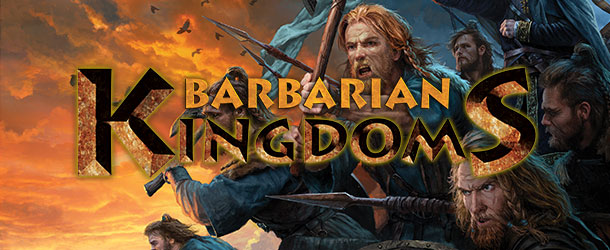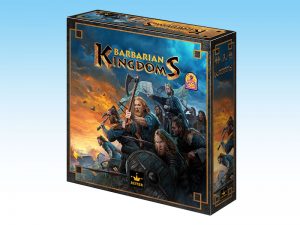In the 5th century AD, the Huns swept into Europe from the East, forcing the various Germanic tribes ever westwards. Hundreds of thousands of Germanic warriors crossed the frozen Rhine, bypassing the fortified defenses of the Roman Empire. The Roman imperial army, undermined by unprecedented internal crises, failed to repel the incursions, and after years of looting, displacement, and war, Rome ceded territories to barbarian warlords who founded their own kingdoms. The depletion of resources, combined with the growing autonomy of the “Barbarian Kingdoms,” marked the demise of the Western Roman Empire. After a thousand years of Roman supremacy, a new era of instability and opportunity began in Europe: the Middle Ages.
This tumultuous era is the setting of Barbarian Kingdoms, a competitive, fast-paced game of conquest and bluff for 2 to 6 players. Each player controls one of six Kingdoms competing for dominance: Huns, Ostrogoths, Vandals, Visigoths, Saxons, and Franks.
When the game designer Christophe Lebrun started to work, together with his wife, Aurélie, on a conquest game – intended to be accessible, fast, deep, replayable, beautiful, asymmetric, fun, and with little randomness – Aurélie immediately thought of the barbarian invasions as a theme. Initially, Christophe thought the theme was more suitable for a cooperative game, or a "one against all" type of game: defending the Roman Empire against the barbarians. However, while searching for sources on this era, he took notice that the 5th century AD – the Early Middle Ages, with the rivalries between young barbarian kingdoms, immediately after the fall of the Roman Empire – was a little-known, complex, and exciting period that lent itself wonderfully to a game of conquest.
In Barbarian Kingdoms, players are immersed in a chaotic struggle for dominance, striving to lead their burgeoning realm through the transition from Antiquity to the Middle Ages. Recruiting warriors, collecting taxes, assaulting provinces, maneuvering units, and claiming territories are strategic actions crucial in the race to be the first to control seven territories or eliminate two rival kings. The game offers balanced asymmetry, ensuring different strategies and high replayability. The game mechanics blend conquest, bluffing, and diplomacy, emphasizing strategic skill over chance.
Barbarian Kingdoms introduces an innovative battle resolution mechanism. A Battle begins for three distinct reasons: when you invade a Province occupied by an enemy unit; when you are challenged after invading an unoccupied Province; or after you claim a Province. Being able to challenge an opponent's action allows players to be personally involved during other players' turns. The "challenge cycle", during which each player announces successively whether they are challenging or passing, invites players to be diplomatic. Once a battle begins, it is resolved immediately.
Battle Points decide the outcome of a Battle. There is an initial Battle Point count: two points if a player controls the Province, three points for a Warrior, and six points for a King. After this initial count, each of the two belligerents takes a purse and secretly places a part of their Treasury in it. When they are ready, they simultaneously exchange the purses and reveal their contents. The money paid by a player increases his Battle Points.
This very original resolution mechanic adds a bluffing dimension to the outcome of a battle, since it is possible to put nothing in your purse at all, or to go "all-in". It also allows to balance the game, as a player who comes out of the battle militarily strengthened will be weakened economically, and vice-versa. Finally, this mechanism eliminates the randomness of dice or card draws, putting players’ skills to the test. The different possible outcomes of these “bets” adds a touch of chaos - a guarantee of replayability - to the whole. The player who loses the battle loses all his engaged units; if a King is defeated, he is eliminated from the game. The victorious units are redeployed to adjacent controlled provinces.
The game ends when the first player meets one of the two victory conditions: Territorial – control of seven territories, or Military – eliminate two opposing Kings. This allows for strategic variety, and allows players to keep on playing... even after the loss of their King. The other players may determine their placement by calculating their Kingdom Scores, counting points for opponent Kings defeated, for their own King being alive, for warriors and control tokens on the game board, and amount in their Treasury.
The engaging gameplay, historical intrigue, and dynamic player interaction make Barbarian Kingdoms a fast-playing, yet deeply strategic and immersive, board game experience.














